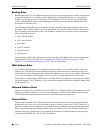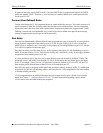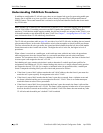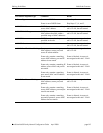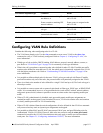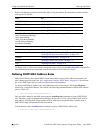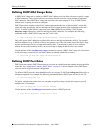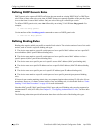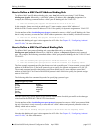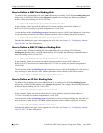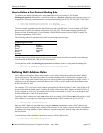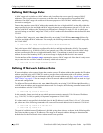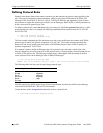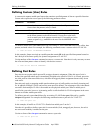
Configuring VLAN Rule Definitions Defining VLAN Rules
page 8-14 OmniSwitch 6600 Family Network Configuration Guide April 2006
Defining DHCP Generic Rules
DHCP generic rules capture all DHCP traffic that does not match an existing DHCP MAC or DHCP port
rule. If none of these other rules exist, then all DHCP frames are captured regardless of the port they came
in on or the frame’s source MAC address. Only one rule of this type is allowed per switch.
To define a DHCP generic rule, enter vlan followed by an existing VLAN ID then dhcp generic. For
example,
-> vlan 255 dhcp generic
Use the no form of the vlan dhcp generic command to remove a DHCP generic rule.
-> vlan 255 no dhcp generic
Defining Binding Rules
Binding rules require mobile port traffic to match all rule criteria. The criteria consists of one of six combi-
nations, each of which is a specific binding rule type:
1 The device must attach to a specific switch port and use a specific MAC address and use a specific IP
network address (MAC-port-IP address binding rule).
2 The device must attach to a specific switch port and use a specific source MAC address and use a
specific protocol (MAC-port-Protocol binding rule).
3 The device must use a specific port and a specific source MAC address (MAC-port binding rule).
4 The device must use a specific IP address and use a specific MAC address (MAC-IP address binding
rule).
5 The device must use a specific port and a specific IP address (port-IP address binding rule).
6 The device must attach to a specific switch port and use a specific protocol (port-protocol binding
rule).
If frames do not contain matching criteria, they are compared against other existing VLAN rules of lower
precedence. However, if a frame violates criteria of any one binding rule, it is discarded. Refer to “Under-
standing VLAN Rule Precedence” on page 8-8 for more information.
Note that MAC-port-IP, MAC-port-Protocol, MAC-port, and port-IP binding rules are also supported on
Authenticated VLANs (AVLANs). See Chapter 21, “Configuring Authenticated VLANs,” for more infor-
mation.
The following subsections provide information about how to define each of the binding rule types.



